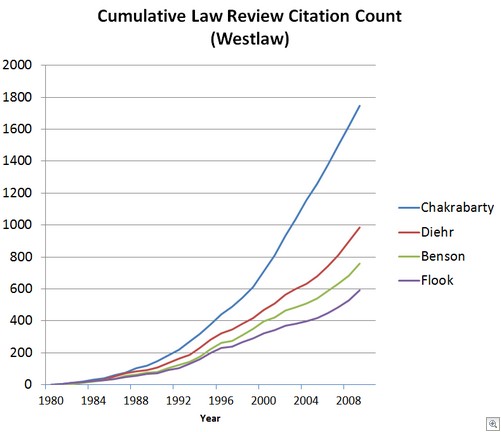The chart above shows the cumulative law review citation count for the Supreme Court's leading pre-Bilski patentable subject matter decisions. The data is based on a westlaw keycite search, each law review article is counted only once per case. Thus, if an article that cites Diehr twenty times only adds one to the tally.

Like totally cool Google today in memory of John Lennon.
“especially since the lines don’t seem to cross at all.”
There’s something very important I forgot to tell you.
What?
Don’t cross the lines.
Why?
It would be bad.
I’m fuzzy on the whole good/bad thing. What do you mean, “bad”?
Try to imagine all life as you know it stopping instantaneously and every molecule in your body exploding at the speed of light.
Total protonic reversal.
Right. That’s bad. Okay. All right. Important safety tip. Thanks, Egon.
(adapted)
How about using some simple geometric shapes instead of colors so that color blind folks can tell what the lines are??? The old xxx’s and ooos and different dashes work great…
You should include not only Funk v Kalo, but O’Reilly v Morse, too. It might be interesting to do a copyright parallel and include Baker v Selden.
EG, you are correct – Bilksi will zoom up the ranks quickly enough.
Bilski 14!
Benson and Flook will never catch up to Diehr. Never. Anytime either are mentioned, Diehr must be mentioned because as Bilski 14 points out – both Benson and Flook are cabin’ed by Diehr.
If it seems as if the Diehrbots have gobbled up the Bensonites and Flookettes, it is because they have. Diehr Rules.
The Stevens legacy of the earlier Supreme Court decisions has been lost and that loss sealed in Bilski. The long and publicly silent battle in the cloistered Supreme Court chambers shows Stevens to be the loser and the actual iventors to be the winners.
Bilski 14!
What this graph may show is that Chakrabarty and Diehr, being the more recent SCOTUS cases, are cited more because they’re viewed as representing the current SCOTUS view on patent-eligibility. You’ll likely see the same thing happen as Bilski is cited in the law reviews.
Agreed that the relative citation count is interesting, especially since the lines don’t seem to cross at all.
For some background, I was doing some research for a Bilski project and spent 20 minutes building this graph on a lark. I completely agree that the increase over time may be largely due to the factors that Anonymous 3:10 suggested. However, what I found interesting was the relative citation count between the four cases.
I wonder if the trend is reflective of an increase of (1) the fact that WL has limited coverage and the further back in time you go the more likely it is that WL simply doesn’t have a particular journal title in the database, (2) a general increase in the overall number of articles and judicial opinions written, and/or (3) an increase in the amount of recent patent scholarship.
I would bet that a significant percentage of the Chakrabarty cites to “anything under the sun that is made by man” falsely misrepresented that statement out of context by failing to also quote the immediately following expressed exceptions to that statement: “This is not to suggest that § 101 has no limits or that it embraces every discovery. The laws of nature, physical phenomena, and abstract ideas have been held not patentable.” [With numerious citations]
Hmmm – what does this say about the proliferation of law review articles?
The Funk Brothers played on Motown hits such as “My Girl”, “I Heard It Through the Grapevine”, “Baby Love”, “Signed, Sealed, Delivered I’m Yours”, “Papa Was a Rollin’ Stone”, “The Tears of a Clown”, “Ain’t No Mountain High Enough”, and “(Love is Like a) Heat Wave,” right?
What about Funk Brothers?
How would you interpret this chart, Dennis? I can’t derive much meaning from it because it’s impossible to say whether the law reviews are supportive or critical of each case.
For example, it’s tempting to say “law review article authors take a positive view of expansive patentable subject matter because they cite cases like Chakrabarty and Diehr more than Benson.”
But it could just as well be that the articles are actually critiquing those cases and citing Benson approvingly. In fact, one could posit that’s more likely because an article that amounts to “the status quo is pretty good” is boring whereas an article that says “the status quo is bad and here is my unique and interesting alternative” is less so.
As you collected the data did you get a sense of which direction the law review articles tended to cut? And out of curiosity, what percentage of the Chakrabarty cites were specifically to page 309 (i.e., “anything under the sun that is made by man”)?
How’s State Street doing these days? I’d imagine it’s gotten some rise as well, or no?
Comments are closed.